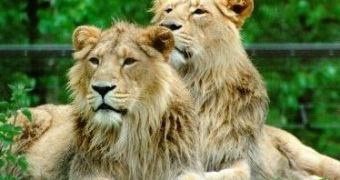During the Ice Age, huge beasts forming the megafauna, like mammoths, saber-toothed cats and woolly rhinos roamed the continents of our planet.
But the Ice Age ended some 10,000 years ago and most of the megafauna disappeared, a fact which is connected to the spread of modern humans. This fauna loss left the Holocene, the current era (which started 10,000 years ago) with a very poor megafauna.
Species like the American mastodon, dire wolf, giant deer and ground sloth are long vanished, but some species, or related subspecies, still persist, and a Pleistocene-like megafauna and their ecosystems can be re-created.
A few years ago, scientists made a "re-wilding" plan aimed at restoring North America's lost Pleistocene ecosystems, while providing a sanctuary for megafauna barely surviving in conflict-ridden, unstable or densely populated areas. But there are other candidates for the re-wilding, like in Siberia, where Pleistocene-like grasslands are preserved and extended, but also Europe, which is a more proper candidate for re-wilding than North America.
Most American lost species do not have any close living relatives.
Even if in some cases, Europe's megafauna also has irreversible extinctions, like the scimitar cat, cave bear, woolly mammoth, woolly rhinoceros, steppe rhinoceros and giant deer, the other species still have close wild or domestic relatives elsewhere in the world. Moreover, Europe's megafauna disappeared more recently than in North America, many species persisting well into the Holocene.
Some megafauna has been successfully reintroduced: see the case of the European bison, extinct in the wild in the early 20th century, which is now present among scattered populations across eastern Europe.
Musk oxen that lived in European Ice Age have been successfully introduced in Scandinavia's mountains. The fallow deer, the closest relative of the extinct giant deer, persisted just in Asia Minor but now, after two millennia of reintroductions, it thrives in many European countries.
Re-wilding initiatives in Europe must also reinvigorate its current megafauna: the wolf, brown bear, lynx and moose. There are 11 additional megafauna species which have been taken into consideration: the Asiatic lion, leopard, spotted hyena, dhole, horse, cattle, Asiatic wild ass, Asiatic elephant, hippopotamus, water buffalo and hairy rhinoceros.
Lions of the extinct spelaea subspecies could be in fact the same with the Asiatic lion and were widespread in Europe until the end of the last glacial period. It persisted in the Balkans till 800 years ago and the Greek legend of the Hercules mentions lions in ancient Greece. Now, the subspecies is limited to forest areas in India due to overhunting.
The leopard, spotted hyena and the dhole (the Asiatic wild dog) were widespread in Europe during the late Ice Age and now they survive in Africa and Asia. Grazing megafauna must serve as prey and fill the ecological void left by extinct herbivores. Horse and cattle flourished in late Ice Age and Holocene Europe, but became extinct in the wild there over the past 400 years due to hunting: the last auroch (wild cattle) in 1627 in Poland, and the last tarpan (European wild horse) in 1918 in captivity in Ukraine. Both species are domesticated and many individuals turned feral.
There are projects of turning back to the wild forms starting with primitive domestic breeds resembling the wild forms, like Heck cattle and horses.
The Asiatic wild ass could also be colonized in Europe's drier regions, filling the niche of the extinct European wild ass, which thrived well into the Holocene, possibly surviving in Spain as late as A.D. 1540.
Other large mammals could replace related but extinct relatives, like the Asiatic elephant for the straight-tusked elephant, which inhabited Europe's warm to cool temperate climates during the late Ice Age. The Asiatic elephant could adapt to Europe's clime, as it is not an exclusively tropical species and it was common in temperate China early in the Holocene.
Modern hippopotamus lived in warm, temperate conditions in Europe during the late Ice Age and the Asian water buffalo had an extinct European relative.
The Sumatran, or hairy rhinoceros, are a species on the brink of extinction in Southeast Asia, which, if saved, could replace the extinct Merck's rhinoceros, a relative that inhabited the European temperate forests and disappeared during the last glacial period.

 14 DAY TRIAL //
14 DAY TRIAL //